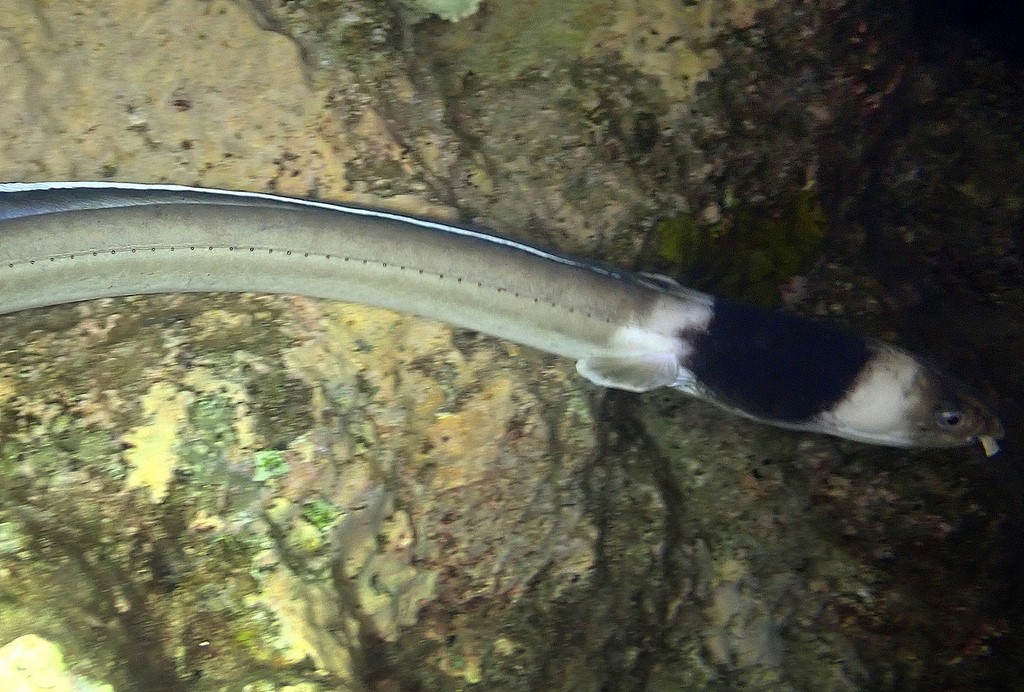OPHICHTHUS CEPHALOZONA - (BLEEKER, 1864)
Picture courtesy of: Amaury Durbano
Actinopterygii (Gigaclass) > Actinopteri (Class) > Teleostei (Subclass) > Elopomorpha (Superorder) > Anguilliformes (Order) > Congroidei (Suborder) > Ophichthidae (Family) > Ophichthinae (Subfamily) > Ophichthus (Genus)
Anguille-serpent Tête Noire, Headsaddle snake eel, One-banded snake-eel, Black-neck snake eel, Blacksaddle snake eel, Darkshoulder snake-eel, Dark-shouldered snake eel, 頸帶蛇鰻,
Synonymes
Muraenopsis marginatus (Bleeker, 1863)
Ophichthys cephalozona (Bleeker, 1864)
-----------------------------
Description
Predorsal vertebrae: 12, preanal vertebrae: 66, total vertebrae: 155-157 (usually: 156). Pectoral fin rays: 13-15; Pectoral fin length: 3-4 in Head Length; Head long: 9.5-11.0 in TL, body depth: 24-30 in TL, and tail length 1.8-1.9 in TL. Body fairly stout, but tail tip sharply pointed; Dorsal and anal fins ending about a snout length before the sharply pointed tip of tail; Pectoral fins rounded. Two small but notable barbels along ventral edge of upper lip. Teeth numerous, small, stout and pointed, uniserial on jaws and vomer. Eye contained: 10-12 times in head and twice in snout. Snout tip distinctly anterior to lower jaw. Max. length: 115 cm TL. Depth range: 0 - 30 m.
Color
Body pale greyish brown dorsally, white ventrally; Wide black band behind head surrounded by wide white bands; Pectoral fins pale with white margins; Median fins black with white or pale margins.
Etymology
Ophichthus: from Greek, ophis = serpent + from Greek, ichthys = fish. Referring to snake-like appearance.
cephalozona: from Greek, kephale = head + from Latin, zōnātus = belted, girdled, zoned. Referring to broad black band across nape.
Original description: Ophichthus cephalozona Bleeker, 1864 - Type localities: Singapore; Ambon Island, Molucca Islands, Indonesia.
Distribution
Indo-West Pacific: India, Myanmar and Indonesia, east to Marshall Islands and Society Islands (French Polynesia), north to Vietnam and Taiwan, south to Queensland (Australia) and New Caledonia.
Biology
Inhabits muddy to sandy inshore areas and occasionally forages in the open at night. Burrowing species. Nocturnally active.
Last update 25, September 2024
Actinopterygii (Gigaclass) > Actinopteri (Class) > Teleostei (Subclass) > Elopomorpha (Superorder) > Anguilliformes (Order) > Congroidei (Suborder) > Ophichthidae (Family) > Ophichthinae (Subfamily) > Ophichthus (Genus)
Anguille-serpent Tête Noire, Headsaddle snake eel, One-banded snake-eel, Black-neck snake eel, Blacksaddle snake eel, Darkshoulder snake-eel, Dark-shouldered snake eel, 頸帶蛇鰻,
Synonymes
Muraenopsis marginatus (Bleeker, 1863)
Ophichthys cephalozona (Bleeker, 1864)
-----------------------------
Description
Predorsal vertebrae: 12, preanal vertebrae: 66, total vertebrae: 155-157 (usually: 156). Pectoral fin rays: 13-15; Pectoral fin length: 3-4 in Head Length; Head long: 9.5-11.0 in TL, body depth: 24-30 in TL, and tail length 1.8-1.9 in TL. Body fairly stout, but tail tip sharply pointed; Dorsal and anal fins ending about a snout length before the sharply pointed tip of tail; Pectoral fins rounded. Two small but notable barbels along ventral edge of upper lip. Teeth numerous, small, stout and pointed, uniserial on jaws and vomer. Eye contained: 10-12 times in head and twice in snout. Snout tip distinctly anterior to lower jaw. Max. length: 115 cm TL. Depth range: 0 - 30 m.
Color
Body pale greyish brown dorsally, white ventrally; Wide black band behind head surrounded by wide white bands; Pectoral fins pale with white margins; Median fins black with white or pale margins.
Etymology
Ophichthus: from Greek, ophis = serpent + from Greek, ichthys = fish. Referring to snake-like appearance.
cephalozona: from Greek, kephale = head + from Latin, zōnātus = belted, girdled, zoned. Referring to broad black band across nape.
Original description: Ophichthus cephalozona Bleeker, 1864 - Type localities: Singapore; Ambon Island, Molucca Islands, Indonesia.
Distribution
Indo-West Pacific: India, Myanmar and Indonesia, east to Marshall Islands and Society Islands (French Polynesia), north to Vietnam and Taiwan, south to Queensland (Australia) and New Caledonia.
Biology
Inhabits muddy to sandy inshore areas and occasionally forages in the open at night. Burrowing species. Nocturnally active.
Last update 25, September 2024
